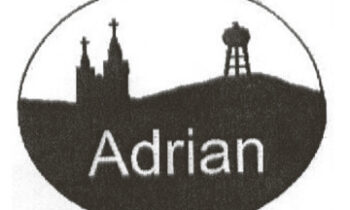By Deb Kroon
Review Staff Writer
Andy and Sara Henning both grew up on dairy farms. Andy is still living and milking on his family’s home place. Sara’s family took the whole-herd buy out of the 1980s and quit milking. Now Andy and Sara are raising their children with this milking background. The Hennings live a little over three miles northwest of Adrian. Andy’s parents, Vern and Rosie Henning established the farm in 1957. Over the years the Hennings have added and deleted herds until now, Andy and Sara, along with Austin (16 years old), Jacob (13 years old) and Whitney (10 years old) settled on their present dairy herd, some chickens, rabbits, cats, a dog and the newest addition-a goose. Along with milking goes all of the other every day and seasonal chores. The Hennings crop farm corn, soybeans and hay. They use the corn and hay to feed and sell the soybeans.
Andy said he’s been milking for 30 years, yet in all that time has never milked by hand, assuring me that he know how. When the Hennings began milking, a stanchion bar was most widely used for milking. In 2005, Andy converted the barn into a milk parlor. The cows stand parallel to each other, eight on a side, with the person who is milking in a cemented trench that runs the length of the parlor. The Henning milking herd is about 100-110 cows, so it takes several hours to complete one milking and the cows are milked twice daily ( 4 a.m. and 4 p.m.).
The milk is stored in a 3000 gallon tank and is kept at a specific temperature. It can be stored for only three days. If for some reason the milk truck can not get to the farm to pick up the milk, it has to be thrown out, so timing is vital to the sale of bulk milk. “It’s strange,” said Sara. “Milk is stored in a 3000 gallon tank, yet sold by the pound.” We had a discussion of milk prices that will be addressed in another story.
One of the unique things about Henning Dairy is the use of sand to bed down their cows instead of traditional straw. Everyday as the herd is taken from the barn for milking, the sand is raked clean into the walkway in the middle of the barn. The “dirty” sand is removed and spread into a special area and washed. A pontoon pump is used to wash the sand clean. It is let dry and then reused (along with some new) for the cows that are not part of the milk herd. “I feel sand is better for the comfort of the cows,” explained Andy. “It helps prevent problems with the teats, is easier to keep clean and we can reuse it. We do get new sand every 2-3 weeks, but it still helps keep costs down.”
The dairy herd is calving all year round. The cows are set up on cycles, so that every five weeks a number of the cows are bred. Andy explained that they count on an expert from the American Breeders Service (ABS) to help select a bull(s) that is right for their herd. For them, they have found that Holsteins and Milking Shorthorns are the best. The Holstein is black and white and the Milking Shorthorn is a smaller, red and white cow.
Andy, with the help of the family (when the kids are not in school) uses cidr inserts to help bring the cows into heat. These are plastic T-shaped devices that are inserted to bring the cow into heat. They are artificially inseminated by Andy with the selected bull semen. Seven days later, he has a vet come out and do an ultrasound on the cows so they have the best chance of picking up an early pregnancy. The Hennings also keep a bull on the farm, just in case a cow would happen to lose her calf and needs to be rebred. After the cow is pregnant, she stays in the milking cycle until 7 months pregnant. At that time she is moved to “vacation” to rest up and get ready to have the calf.
There are six different barns on the Henning farm. One barn is for the babies. They are kept there and fed their mother’s milk enriched with vitamins to ensure good health until they are about 40 days old. They are transitioned off of milk to corn before being moved to the heifer pen. There is a hoop barn (the grower) for the smaller babies to allow them to grow some before being put in with the heifers. “The reason for all the different barns,” Sara explained, “is so that the animals in each pen remain close to the same size. That way a larger heifer can’t push a smaller one away from food.” The heifer pen is a large open sided barn that has three separate areas. The first is for the smaller heifers who have not been bred. Once they are old enough and bred, they are moved to the next pen (newly bred), and then when they are confirmed pregnant, they are moved to the third pen.
The free stall barn is the largest of the barns. This is where the milking herd is kept. A cow is not considered a milk cow until she has had a calf, so this barn contains pregnant cows and cows waiting to be bred. They are taken from here to the milking parlor, and then put back into the barn. The “vacationing” cows, or dry cows are away from the milking herd until they calf. Once the calf is born, they are milked again, but with a smaller milker. The milk is not put into the bulk tank, but used to feed the babies. The milk is tested regularly. This is to be sure all of the antibiotics given to help with the calf is completely gone from the milk before the cow can be put back into rotation. Her milk can not be sold until the milk tests antibiotic free.
About three years ago, Sara and Andy gave the kids a cow of their own and the three also bought a cow. This is to give them a chance to invest in starting their own herds, Sara said. She is teaching them to track their own herd, so they understand what goes into raising a dairy herd. They make the decisions for their cows, including what bull they are bred with. Whitney showed me a catalog of bulls (one of several they had) where you could choose a specific bull to buy semen to breed the cows. It was amusing for someone who has no experience with livestock to see a catalog of posing bulls! The younger Hennings have decided to stay with the advice of the ABS professional for their bull. All three of the Henning kids are involved in 4-H and are showing their animals at the Nobles County Fair and the State Fair if they win. They sell the ribbons won at Nobles County Fair to raise the money for texpanding their herds.
To date, Austin who started with one cow and a Milking Shorthorn, now has 2 milk cows and 2 calves in his herd. Jacob as had a bit harder time. He also started as Austin, with one cow from his parents and one that was bought, but has only one cow right now. His luck has been to have steers instead of heifers. The steers are sold, and he is trying to find a cow that will give him heifers. Whitney’s herd is doing well. She has three cows and a calf (about 4 months old). She’s not sure how many others she has- just“lots” she told me. All three will be showing at the Nobles County Fair coming up in August.
We talked about the future of the Henning Dairy. Of the three younger Hennings, Austin has no real interest in remaining in milking. He wants to move north. He said he likes the crop farming, but has no desire to stay in milking. He wants to be somewhere that he can hunt and fish. Jacob wants to be involved in the dairy. He has quite an interest in the whole operation and wants to stay. Whitney as of now also wants to stay involved in the dairy farm.
The Henning parentals said they feel the future is uncertain. Prices of milk go up and down, labor is hard to find. They work 16 hour days with not much time off. They’d love to be able to find help so they could take a vacation now and then. When they do have to be gone, one of Andy’s brothers fills in for them. Sara stated that they put their hearts into their work and it is the emotional part of the farm that is the hardest to handle. “We work our hearts out and really don’t know what the outcome in the long run will be. The programs from the government sound good,” she went on, “but by the time it gets divided among all the dairy people, our share doesn’t even pay one month’s light bill.”
Even with an unsure extended future, the Hennings love what they do and with at least two of the next generation wanting to stay in the business, we will probably see the “Henning Dairy” sign stay on the farm for years to come.
We salute the hard work of the Dairy Farmer.






